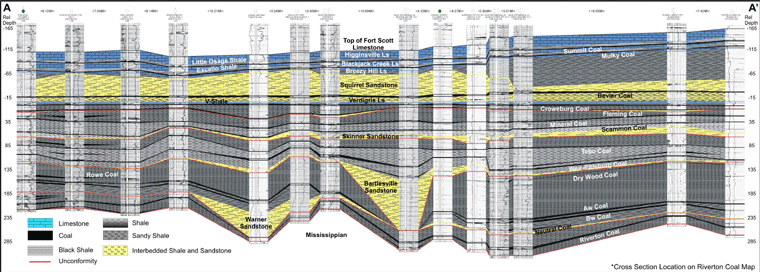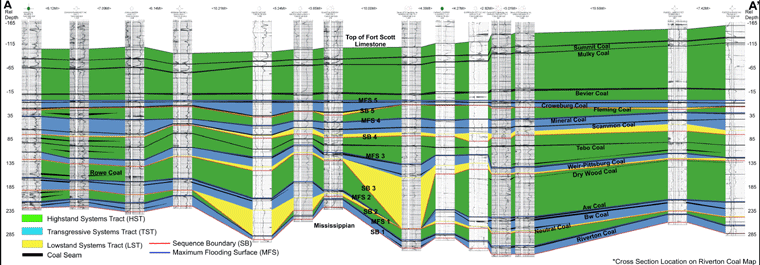 |
|
Kansas Geological Survey Open-file Report 2003-28 |
Sequence Stratigraphy
Sequence stratigraphic concepts provide a model to explain and predict the lateral distribution, relative thickness and ash content of coal beds in the Cherokee Group. The preservation and continued growth of peat is dependent on a rising water table and high accommodation space achieved by relative base level rise (McCabe & Parrish, 1992). The most extensive, thickest, and lower ash coals are interpreted to occur at or near the maximum flooding surface at the end of the deposition of the transgressive systems tract. However, coals are not restricted to the end of the transgressive systems tract and can occur in any systems tract. Incised valleys and lateral equivalent interfluves are interpreted as sequence boundaries. Systems tracts are identified on the basis of vertical changes in lateral extent and thickness of coals. Generally coals tend to thicken and become more laterally extensive up through the transgressive systems tract and thin upward through the highstand systems tract (Aitken, 1994).
Five sequences are identified in the Cherokee Group of the Cherokee basin. Thin discontinuous coals such as the Tebo, Rowe, and Dry Wood coals are considered to be a part of the highstand systems tract. Extensive but thinner coals such as the Bw coal, are considered as part of the transgressive systems tract. The Riverton, Aw, Weir-Pittsburg, Mineral, and Croweburg coals are identified as the thickest coals in each sequence and are associated with overlying relatively thick black shales that are interpreted as maximum flooding surfaces.
Stratigraphic Dip Cross-Section Through the Cherokee
Basin (Datum on the V-Shale)
Click on Image for Larger Cross Section (1500x530 pixels)

Sequence Stratigraphic Cross-Section Through the
Cherokee Basin (Datum on the V-shale)
Click on Image for Larger Cross Section (1500x530 pixels)
|
|
e-mail : webadmin@kgs.ku.edu
Last updated May 2003
http://www.kgs.ku.edu/PRS/publication/2003/ofr2003-28/P2-03.html
